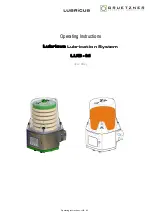
how the Reverse Osmosis System Works
Reverse Osmosis reduces Total Dissolved Solids (TDS) and organic matter from water by diffusing it through a special membrane
(see Performance Data Sheet). The membrane separates minerals and impurities from the water and they are flushed to the
drain. For the reduction of the claims specified, see Performance Data Sheet. High quality product water goes directly to the
drinking water faucet or to the storage tank. The system makes a good supply of drinking water each day. How much it makes
depends on the feed water supply pressure, temperature and quality.
The prefilter and postfilter are replaceable cartridges. The carbon prefilter reduces chlorine while also filtering sediments.
The postfilter reduces any other undesirable tastes and odors before you use the water.
These systems include an electronic faucet assembly with a prefilter and postfilter change reminder, Reverse Osmosis membrane
change reminder and a status okay reminder.
The prefilter and postfilter change reminder will flash amber after six months have passed or 900 gallons have been used. When
this occurs, it is time to replace these cartridges and sanitize the system.
The membrane change reminder flashes amber when the TDS monitor in the system has measured the amount of impurities
removed is less than 75%. When this occurs, it is time to replace this Reverse Osmosis membrane cartridge and sanitize the system.
Finally, a green flashing light will indicate the system is functioning properly.
Description of the Reverse Osmosis System
Prefilter—
Water from the cold supply pipe is directed to
the prefilter cartridge. The prefilter is a replaceable sediment
cartridge containing activated carbon. The prefilter reduces chlorine
taste and odor in the feed water because
cHLORINEDEstROystHE
REVERsEOsMOsIsMEMBRaNE.
Filtered, clean, chlorine-reduced water
flows from the prefilter to the Reverse Osmosis cartridge.
Reverse Osmosis Cartridge—
The middle cartridge includes a
tightly wound, special membrane. Water is forced through the
cartridge where the membrane reduces the dissolved solids and
organic matter. For the reduction of the claims specified, see
Performance Data Sheet. High quality product water exits the
Reverse Osmosis cartridge and goes to the storage tank. Reject
water, with the dissolved solids and organic matter, leaves the
cartridge and is discharged to the drain through 1⁄4
”
tubing.
Postfilter—
After leaving the storage area, but before going
to the system faucet, product water goes to the postfilter
cartridge. The postfilter is also a replaceable sediment cartridge
that contains activated carbon. Any remaining tastes, odors or
sediments are reduced from product water by the postfilter.
Clean, high quality drinking water flows through the tubing
and to the system faucet.
Storage Tank—
The storage area holds up to 2-1/2 gallons
of product water. A diaphragm inside the tank keeps water
pressurized, when the tank is full, for fast flow to the faucet
when drinking water is needed.
3
4
2
1
About the reverse osmosis system.
GEAppliances.com
5
Co
ns
um
er
S
up
po
rt
Tro
ub
les
ho
ot
in
g T
ip
s
O
pe
ra
tin
g I
ns
tru
cti
on
s
Sa
fe
ty
In
str
uc
tio
ns
In
sta
lla
tio
n
In
str
uc
tio
ns
Содержание PNRQ20RBL
Страница 26: ...Parts list 26 PNRQ20RBL PNRQ21RBN PNRQ21RRB ...
Страница 54: ...Liste de pièces 54 PNRQ20RBL PNRQ21RBN PNRQ21RRB ...
Страница 56: ...Fonctionnement Mesures de sécurité Installation Conseils de dépannage Soutien au consommateur 56 Notes ...
Страница 83: ...83 Soporte al consumidor Solucionar problemas Operación Seguridad Instalación Notas ...
Страница 84: ...Lista de partes 84 PNRQ21RBN PNRQ21RRB ...






































